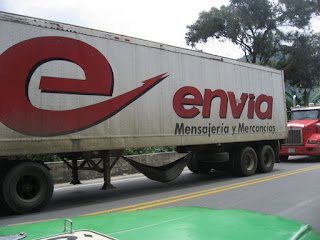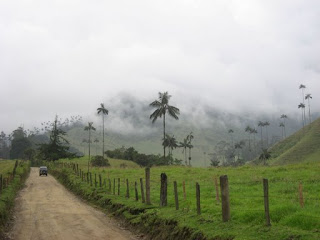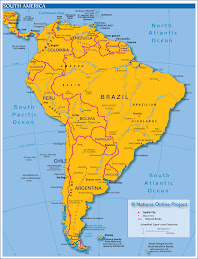`Really? What city?`
`Angola.`
`Right.`
These are the kinds of conversations we have to put up with on a regular basis. I fear that loads of tourists will be scattered around the southern area of Africa in 2010 wondering where the world cup is, because no one seems to understand that South Africa is a country. Recently, an Israeli chap displayed such careless and dismissive ignorance about South Africa that I was temped to ask whether Israel was somewhere within Palestine. I held back, for fear the Uzi.
Onto more recent events. We are currently in an internet cafe in Cartagena de Indias, on the Caribbean coast of Colombia. The guy who runs the internet cafe uses it as a promotional tool for his soft rock/fusion band, in which he plays guitar AND sings (he has told me this 5 times). I am so sick of hearing his 3 songs, which he sings along to just to prove that he is the singer, that I am currently looking up the necessary vocab to express myself properly (I can´t seem to find `wanker` in Spanish). He also uses his customers to practice his English, a process which takes a long long time. Ah he´s playing the first song again - I already know all the words to this one.
Right, now that I´ve got that out the way. Here are some pics from Medellin, which I forgot to put in the last blog. www.picasaweb.google.com/steveo.zogg/Medellin
From Medellin we could not bear the thought of the 14 hour bus ride up to Santa Marta. However, the flight was far too expensive, and we had no choice, so we manned up and boarded the overnight bus, set to arrive at 9am. At 9am we were nowhere near Santa Marta. At 1pm we were no where near Santa Marta. At 4pm, after two roadblocks, tyre burnings, alternate routes, being stuck in the mud, and a bus change, we arrived in... The Most Humid Place on Planet Earth. We found ourselves looking up to see if it was raining, saw clear skies and realised it was our own sweat that was pouring down off our faces and onto the floor. After checking into a hostel, having 5 cold showers and still not knowing what to do with ourselves, we walked down to the beach and had dinner. Getting to sleep in 35 degrees and 90% humidity, we´ve discovered, is quite difficult.
The next day we caught a bus to Parque Nacional Tayrona, a pretty special place where mountains covered in Amazon rain forest meet stark white caribbean beaches, and with the whole huge area being a national park, its been left completely pristine. We had heard that food and drinks within the park were hellishly pricey and that the food was not good at all, so we took supplies with us, including a bottle of rum (when in the caribbean), which our driver smuggled inside the park for us. At the park entrance we were thoroughly searched by the army, who were presumably looking for cocaine. I should rephrase that - the men wearing uniform lightly searched most of the passengers, and roughly molested me. Seriously, he skipped the pockets and went straight for the balls. Twice. I told him that he could at least buy me dinner first, but the humour was lost on him, since he only had one thing on his mind - my manhood. I haven´t heard from Sergent Ramires since - not even a phonecall.
 The truck dropped us off at the start of the path through the jungle, and we began to walk through the humid sweaty rainforest. After about an hour, we emerged out of the jungle onto the snow white sands and the bright blue water of the Caribbean. We had another 1 hour walk along the coast, through the tiny idyllic bays, and eventually arrived at the Cabo, the campsight where we managed to rent some hammocks on the beach to sleep in. We put our stuff down and dove straight into the azure luke warm waters. The beaches were virtually empty and looked like they were straight out of a post card - the slightly bent palm tree, the clean white sand, and the sea. The sea was the best part of all of it - the water was bright blue, completely calm and so clear you could see fish while underwater without using goggles. Just behind the beach was the thick jungle, which receeded up into the mountains. The sun shone for pretty much every day we were there. I can´t say much more about the place, except that it bore all the signs of idyllic paradise.
The truck dropped us off at the start of the path through the jungle, and we began to walk through the humid sweaty rainforest. After about an hour, we emerged out of the jungle onto the snow white sands and the bright blue water of the Caribbean. We had another 1 hour walk along the coast, through the tiny idyllic bays, and eventually arrived at the Cabo, the campsight where we managed to rent some hammocks on the beach to sleep in. We put our stuff down and dove straight into the azure luke warm waters. The beaches were virtually empty and looked like they were straight out of a post card - the slightly bent palm tree, the clean white sand, and the sea. The sea was the best part of all of it - the water was bright blue, completely calm and so clear you could see fish while underwater without using goggles. Just behind the beach was the thick jungle, which receeded up into the mountains. The sun shone for pretty much every day we were there. I can´t say much more about the place, except that it bore all the signs of idyllic paradise. Before you get too jealous, try to imagine sleeping in a hammock for three nights, pools of sweat collecting, and squadrons of giant mosquitos carrying out planned attacks on your ankles. The idea of a hammock on the beach sounds romantic and appealing, but the reality is slightly different, especially when you have been badly burnt by the vicious Caribbean sun. Also, eating canned tuna and crackers for every meal is not fantastic.
Not that any of this matters when you can wake up every morning, walk 10 steps from where you are sleeping and take your morning shower in the Caribbean sea, before having a long morning nap in the shade of a palm tree, your only worry being falling coconuts. Those were actually a worry though - a 1kg coconut falling from 20m up could cause a lot of damage to your head. We got through without being rendered retarded by a coconut. Our days were spent switching from lying on the beach to swimming in the sea, with sporadic breaks taken to injest our tuna and cracker rations, often washed down with rum. I´m not entirely sure why people in the Caribbean enjoy rum so much, because it warms you up, and being warmed up is just about the last thing you want to be - its right up there with being raped by a pirate. At night we lay in our hammocks, beating off the mosquitos. One night I fell asleep listening to my iPod, woke up to some noise, and realised it was an English girl with a terribly annoying and loud voice shouting nearby. My iPod told me it was 4:30am, which outraged me, so I got up and unleashed hell on the poor rosbif lass, not realising that my iPod clock was wrong and that it was actually only about 11:30pm. That was slightly embarassing.
and take your morning shower in the Caribbean sea, before having a long morning nap in the shade of a palm tree, your only worry being falling coconuts. Those were actually a worry though - a 1kg coconut falling from 20m up could cause a lot of damage to your head. We got through without being rendered retarded by a coconut. Our days were spent switching from lying on the beach to swimming in the sea, with sporadic breaks taken to injest our tuna and cracker rations, often washed down with rum. I´m not entirely sure why people in the Caribbean enjoy rum so much, because it warms you up, and being warmed up is just about the last thing you want to be - its right up there with being raped by a pirate. At night we lay in our hammocks, beating off the mosquitos. One night I fell asleep listening to my iPod, woke up to some noise, and realised it was an English girl with a terribly annoying and loud voice shouting nearby. My iPod told me it was 4:30am, which outraged me, so I got up and unleashed hell on the poor rosbif lass, not realising that my iPod clock was wrong and that it was actually only about 11:30pm. That was slightly embarassing.
 and take your morning shower in the Caribbean sea, before having a long morning nap in the shade of a palm tree, your only worry being falling coconuts. Those were actually a worry though - a 1kg coconut falling from 20m up could cause a lot of damage to your head. We got through without being rendered retarded by a coconut. Our days were spent switching from lying on the beach to swimming in the sea, with sporadic breaks taken to injest our tuna and cracker rations, often washed down with rum. I´m not entirely sure why people in the Caribbean enjoy rum so much, because it warms you up, and being warmed up is just about the last thing you want to be - its right up there with being raped by a pirate. At night we lay in our hammocks, beating off the mosquitos. One night I fell asleep listening to my iPod, woke up to some noise, and realised it was an English girl with a terribly annoying and loud voice shouting nearby. My iPod told me it was 4:30am, which outraged me, so I got up and unleashed hell on the poor rosbif lass, not realising that my iPod clock was wrong and that it was actually only about 11:30pm. That was slightly embarassing.
and take your morning shower in the Caribbean sea, before having a long morning nap in the shade of a palm tree, your only worry being falling coconuts. Those were actually a worry though - a 1kg coconut falling from 20m up could cause a lot of damage to your head. We got through without being rendered retarded by a coconut. Our days were spent switching from lying on the beach to swimming in the sea, with sporadic breaks taken to injest our tuna and cracker rations, often washed down with rum. I´m not entirely sure why people in the Caribbean enjoy rum so much, because it warms you up, and being warmed up is just about the last thing you want to be - its right up there with being raped by a pirate. At night we lay in our hammocks, beating off the mosquitos. One night I fell asleep listening to my iPod, woke up to some noise, and realised it was an English girl with a terribly annoying and loud voice shouting nearby. My iPod told me it was 4:30am, which outraged me, so I got up and unleashed hell on the poor rosbif lass, not realising that my iPod clock was wrong and that it was actually only about 11:30pm. That was slightly embarassing. 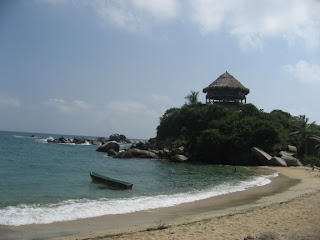

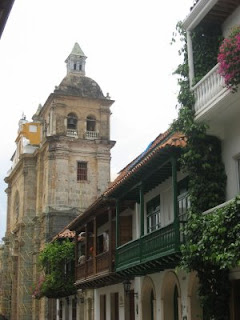 Eventually we decided to leave paradise, and so we packed up and made the trek back through the jungle and caught a ride back to Santa Marta, where we eventually found a bus to take us to Cartagena, where we are now.
Eventually we decided to leave paradise, and so we packed up and made the trek back through the jungle and caught a ride back to Santa Marta, where we eventually found a bus to take us to Cartagena, where we are now.Cartagena is quite possibly the most beautiful city we have seen on this continent. Its position on a large peninsula in the Caribbean means it is virtually surrounded on all sides by turquoise water. What makes it so special is its colonial past, the sense of history you get while exploring it.
The city, called Cartagena de Indias, was founded in 1533, and was the most important port and city for the Spanish in the early days of colonisation (otherwise known as `killing the natives`). However, Cartagena was used as the storage city by the Spanish for the gold they  had plundered from the indiginous people, and combined with the vulnerability from the sea, Cartagena was a pirates wet dream (arrrrrgggh). It was attacked and put under siege by pirates throughout its early history, including John Hawkins and Francis Drake, until eventually massive walls with watchtowers and cannons were built around the whole city to protect it from the pirate cannonfire. These walls are still in almost perfect condition and still surround the Cartagena´s old town, which is a labyrinth of beautiful old colonial buildings and streets and looks like it should be a museum, but, incredibly, its a functioning part of the city, a living exhibit of a colonial Caribbean port city. To make things even better, all the old colonial buildings and the fort walls are all lit up at night by their own individual lights, which makes strolling around the city at night a pretty magical experience. To enter or exit the old town, you have to pass through the 6m thick walls at the clock tower. This part of the city is still protected by many many policemen, guarding against the modern-day pirates who want to rob the gringos, so the old city is perfectly safe. What makes Cartagena so special is being able to enjoy a meal or a drink in one of the many centuries old squares and look over at the massive fortress like sea walls and cannons - the same cannons which fired at pirate ships hundreds of years ago. Arrrrg, I say. Ho ho ho an a bottle o rum.
had plundered from the indiginous people, and combined with the vulnerability from the sea, Cartagena was a pirates wet dream (arrrrrgggh). It was attacked and put under siege by pirates throughout its early history, including John Hawkins and Francis Drake, until eventually massive walls with watchtowers and cannons were built around the whole city to protect it from the pirate cannonfire. These walls are still in almost perfect condition and still surround the Cartagena´s old town, which is a labyrinth of beautiful old colonial buildings and streets and looks like it should be a museum, but, incredibly, its a functioning part of the city, a living exhibit of a colonial Caribbean port city. To make things even better, all the old colonial buildings and the fort walls are all lit up at night by their own individual lights, which makes strolling around the city at night a pretty magical experience. To enter or exit the old town, you have to pass through the 6m thick walls at the clock tower. This part of the city is still protected by many many policemen, guarding against the modern-day pirates who want to rob the gringos, so the old city is perfectly safe. What makes Cartagena so special is being able to enjoy a meal or a drink in one of the many centuries old squares and look over at the massive fortress like sea walls and cannons - the same cannons which fired at pirate ships hundreds of years ago. Arrrrg, I say. Ho ho ho an a bottle o rum.
 had plundered from the indiginous people, and combined with the vulnerability from the sea, Cartagena was a pirates wet dream (arrrrrgggh). It was attacked and put under siege by pirates throughout its early history, including John Hawkins and Francis Drake, until eventually massive walls with watchtowers and cannons were built around the whole city to protect it from the pirate cannonfire. These walls are still in almost perfect condition and still surround the Cartagena´s old town, which is a labyrinth of beautiful old colonial buildings and streets and looks like it should be a museum, but, incredibly, its a functioning part of the city, a living exhibit of a colonial Caribbean port city. To make things even better, all the old colonial buildings and the fort walls are all lit up at night by their own individual lights, which makes strolling around the city at night a pretty magical experience. To enter or exit the old town, you have to pass through the 6m thick walls at the clock tower. This part of the city is still protected by many many policemen, guarding against the modern-day pirates who want to rob the gringos, so the old city is perfectly safe. What makes Cartagena so special is being able to enjoy a meal or a drink in one of the many centuries old squares and look over at the massive fortress like sea walls and cannons - the same cannons which fired at pirate ships hundreds of years ago. Arrrrg, I say. Ho ho ho an a bottle o rum.
had plundered from the indiginous people, and combined with the vulnerability from the sea, Cartagena was a pirates wet dream (arrrrrgggh). It was attacked and put under siege by pirates throughout its early history, including John Hawkins and Francis Drake, until eventually massive walls with watchtowers and cannons were built around the whole city to protect it from the pirate cannonfire. These walls are still in almost perfect condition and still surround the Cartagena´s old town, which is a labyrinth of beautiful old colonial buildings and streets and looks like it should be a museum, but, incredibly, its a functioning part of the city, a living exhibit of a colonial Caribbean port city. To make things even better, all the old colonial buildings and the fort walls are all lit up at night by their own individual lights, which makes strolling around the city at night a pretty magical experience. To enter or exit the old town, you have to pass through the 6m thick walls at the clock tower. This part of the city is still protected by many many policemen, guarding against the modern-day pirates who want to rob the gringos, so the old city is perfectly safe. What makes Cartagena so special is being able to enjoy a meal or a drink in one of the many centuries old squares and look over at the massive fortress like sea walls and cannons - the same cannons which fired at pirate ships hundreds of years ago. Arrrrg, I say. Ho ho ho an a bottle o rum. I don´t think the walls kept all the pirates out. I think many of them still live here in Cartagena, on the very street we´re staying on. Our hostel is not exactly in the most pleasant of areas - it lies outside the old town walls, where the pirates run free. Everyday, we walk out our hostel onto a street filled with crazy people who talk to themselves, spit a lot, are dressed in rags and drink rum out of the bottle. Many of them have only one leg. They often shout incomprehensible things at us - I think it might be the caribbean spanish equivalent of `Shiver me Timbers`. Despite the pirates, we stay in a conveniently located area with lots of good cheap restaurants.
 We have spent most of our time exploring the old town, which mainly involves gauking at its beauty while getting lost in it. Unfortunately, a lot of our time has been taken up by doing admin in preparation for our trip to Cuba, which begins on Friday 19th Sept. The main problem has been trying to track down some damn Euros to take. Since Castro isn´t too fond of Bush, to change US dollars into cuban pesos you get hit with a 20% comission! However, every place offering money exchange here only actually offers dollars or colombian pesos. Eventually, after a lot of wasted time, we found a man named Oscar who had lots of Euros, who sold them to us at a very reasonable rate, thus ending the Euro Saga.
We have spent most of our time exploring the old town, which mainly involves gauking at its beauty while getting lost in it. Unfortunately, a lot of our time has been taken up by doing admin in preparation for our trip to Cuba, which begins on Friday 19th Sept. The main problem has been trying to track down some damn Euros to take. Since Castro isn´t too fond of Bush, to change US dollars into cuban pesos you get hit with a 20% comission! However, every place offering money exchange here only actually offers dollars or colombian pesos. Eventually, after a lot of wasted time, we found a man named Oscar who had lots of Euros, who sold them to us at a very reasonable rate, thus ending the Euro Saga.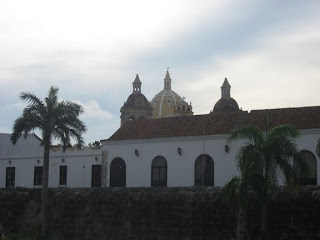 Other than that, we have just been getting to know the place, relaxing, and trying to endure the neverending humidity. We are on quite a tight budget, since we have changed all our money to Euros and only have a few Colombian pesos remaining, so we are living cheaply. When we realised we were on such a tight budget, we did the reasonable thing and spent most of our remaining money on sketches of Cartagena. Whoops. Today we went to explore Cartagena´s biggest fort, Castillo de San Fellipe, which was used as the central fort to defend the city. It was rather cool.
Other than that, we have just been getting to know the place, relaxing, and trying to endure the neverending humidity. We are on quite a tight budget, since we have changed all our money to Euros and only have a few Colombian pesos remaining, so we are living cheaply. When we realised we were on such a tight budget, we did the reasonable thing and spent most of our remaining money on sketches of Cartagena. Whoops. Today we went to explore Cartagena´s biggest fort, Castillo de San Fellipe, which was used as the central fort to defend the city. It was rather cool. 

That concludes the final blog on South America. Tomorrow we leave this continent and fly to Cuba, where we will be for a bit over two weeks before returning home to Angola, the famous South African city. Its been a completely crazy journey which has taken us through such complete opposites - from the freezing Bolivian highlands to the humid Carribean, from sophisticated cities to dusty jungle towns, from the Southern hemisphere to the Northern Hemisphere - we´ve pretty much seen a continent in 6 months.
We´ve got a long wait in the Sao Paulo airport before our flight home, so, if we have the money, we´ll write our final blog about Cuba. Until then amigos,
Adios!
www.picasaweb.google.com/steveo.zogg/SantaMarta










 While in Cali we began to eat a lot of fruit. Colombia has incredibly fertile soil - you notice this
While in Cali we began to eat a lot of fruit. Colombia has incredibly fertile soil - you notice this 










